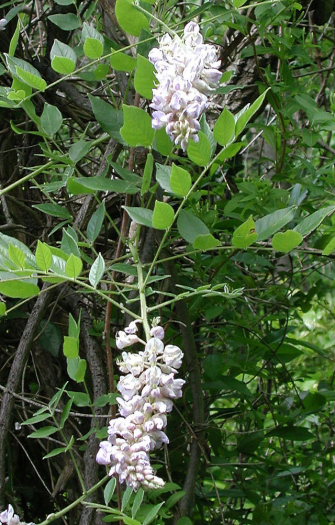Kentucky Wisteria
(Wisteria frutescens subsp. macrostachya)
Kentucky Wisteria (Wisteria frutescens subsp. macrostachya)
/
/

Jaknouse
CC BY-SA 3.0
Image By:
Jaknouse
Recorded By:
Copyright:
CC BY-SA 3.0
Copyright Notice:
Photo by: Jaknouse | License Type: CC BY-SA 3.0 | License URL: https://creativecommons.org/licenses/by/2.0 | Uploader: Jaknouse | Publisher: Wikimedia Commons |



Estimated Native Range
Summary
Wisteria frutescens subsp. macrostachya, commonly known as Kentucky Wisteria or American Wisteria, is a deciduous vine native to wetlands, pond margins, and stream banks of the Southeastern United States. It is a less aggressive and more manageable species compared to its Asian relatives, making it a preferred choice for gardeners. This vine can rapidly grow to a height of 15-25 feet (4.6-8 meters) and is known for its pendulous clusters of fragrant, lilac-purple flowers that bloom in late spring to early summer. The flowers are followed by smooth, flat seed pods that mature in summer and may persist into winter.
Kentucky Wisteria is valued for its stunning floral display and ability to attract pollinators such as bees and butterflies. It is often used for ornamental purposes, such as covering arbors, pergolas, and fences, or trained to grow on trellises. It requires a sturdy structure for support due to its twining growth habit. While it thrives in full sun to part shade, it prefers moist, well-drained soils with a neutral to slightly acidic pH. Regular pruning is necessary to control its size and promote flowering. It is generally resistant to pests and diseases, but can occasionally suffer from fungal leaf diseases or be infested by pests such as aphids and scale insects. Kentucky Wisteria is not considered invasive within its native range, but care should be taken when planting in other regions to prevent potential spread.CC BY-SA 4.0
Kentucky Wisteria is valued for its stunning floral display and ability to attract pollinators such as bees and butterflies. It is often used for ornamental purposes, such as covering arbors, pergolas, and fences, or trained to grow on trellises. It requires a sturdy structure for support due to its twining growth habit. While it thrives in full sun to part shade, it prefers moist, well-drained soils with a neutral to slightly acidic pH. Regular pruning is necessary to control its size and promote flowering. It is generally resistant to pests and diseases, but can occasionally suffer from fungal leaf diseases or be infested by pests such as aphids and scale insects. Kentucky Wisteria is not considered invasive within its native range, but care should be taken when planting in other regions to prevent potential spread.CC BY-SA 4.0
Plant Description
- Plant Type: Vine
- Height: 15-25 feet
- Width: 4-8 feet
- Growth Rate: Rapid
- Flower Color: Purple
- Flowering Season: Spring, Summer
- Leaf Retention: Deciduous
Growth Requirements
- Sun: Full Sun, Part Shade
- Water: Medium
- Drainage: Medium
Common Uses
Bee Garden, Bird Garden, Butterfly Garden, Hummingbird Garden, Potted Plant, Showy Flowers
Natural Habitat
Native to wetlands, pond margins, and stream banks in the Southeastern United States
Other Names
Common Names: American wisteria
Scientific Names: , Wisteria frutescens subsp. macrostachya, Bradlea macrostachys, Diplonyx elegans, Glycine frutescens var. magnifica, Kraunhia macrostachys, Thyrsanthus floridana, Wisteria frutescens var. macrostachya, Wisteria frutescens var. magnifica, Wisteria macrostachya
GBIF Accepted Name: